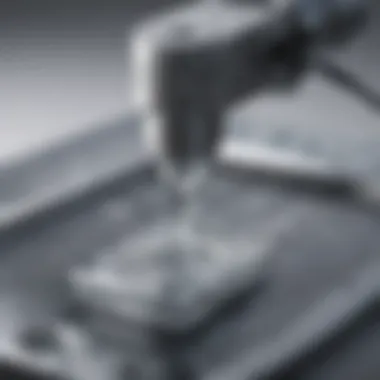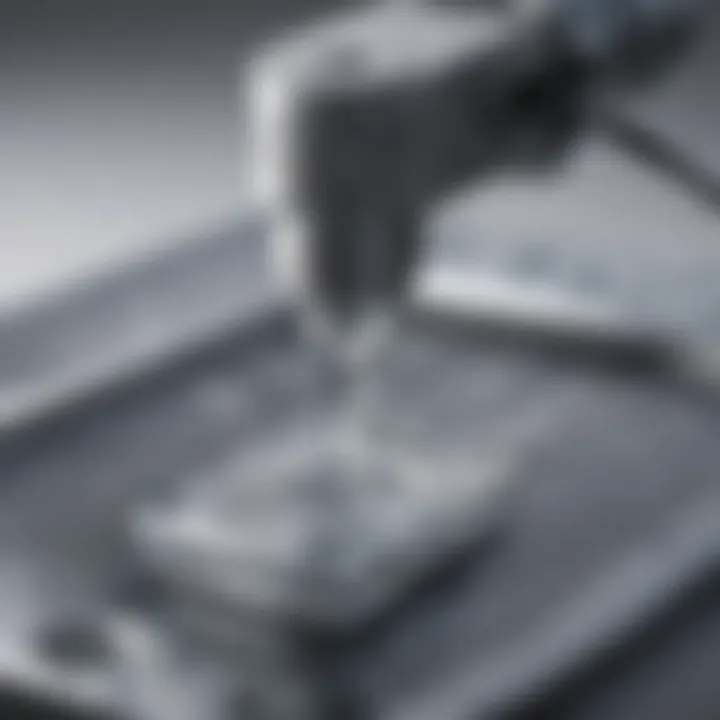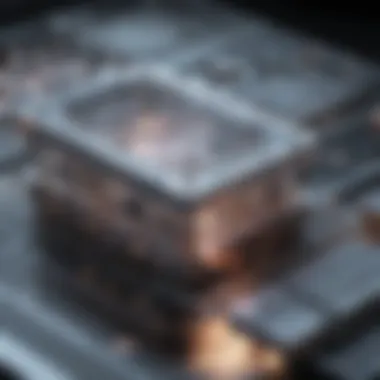Exploring PDMS Microfluidic Devices: Design and Uses


Intro
Microfluidic devices have surged in significance across various scientific domains, particularly in biology and chemistry. Among these devices, those fabricated from Polydimethylsiloxane (PDMS) stand out due to their unique properties and advantages. This article aims to provide an in-depth examination of PDMS microfluidic devices, focusing on their design principles, methods of fabrication, and multiple applications.
The importance of understanding these devices lies not only in their function but also in the innovations they enable in research and practical applications. PDMS microfluidics offer advantages such as flexibility, optical clarity, and ease of fabrication, making them favorable for various experiments and diagnostic processes.
As we progress through this article, we will explore the multiple factors contributing to the rise of PDMS microfluidic technology, including their design intricacies and the challenges often encountered during their construction. This exploration will serve as a valuable resource for students, educators, and researchers who wish to navigate the vast landscape of microfluidics.
Research Overview
Summary of Key Findings
PDMS microfluidic devices have been the subject of extensive academic investigation. Key findings indicate that these devices can streamline chemical reactions and biological assays. The gas permeability of PDMS allows for aerobic processes to occur within the devices. Furthermore, the compatibility of PDMS with various materials leads to greater versatility in applications ranging from drug delivery systems to diagnostic tools.
Importance of the Research in its Respective Field
Understanding PDMS microfluidic devices is crucial as these technologies have profound implications for both biological and chemical scientific communities. The ability to manipulate small volumes of fluids with precision fosters advancements in lab-on-a-chip technology and point-of-care diagnostics. Researchers can leverage PDMS microfluidics to develop novel platforms that accelerate research outcomes and enhance medical diagnostics.
"The growth of PDMS microfluidics represents a key direction in the interdisciplinary application of nanotechnology, biology, and chemistry, promoting pioneering research and development."
Methodology
Description of the Experimental or Analytical Methods Used
The fabrication of PDMS microfluidic devices typically involves a two-part process: soft lithography and casting. First, a master mold is created using photolithography, which allows for precise control over the channel designs. Next, PDMS is mixed and poured over the master mold, capturing the desired features.
Sampling Criteria and Data Collection Techniques
In research studies, a variety of techniques for sampling and data collection are employed. Clear criteria must be established to determine the relevance and quality of the microfluidic designs. Subsequently, data collection can incorporate methods like microscopy for channel analysis, fluorescence for biological assays, and precise volumetric measurements for fluid dynamics.
This systematic approach to designing and fabricating PDMS microfluidic devices ensures both efficiency and reliability in their development and use.
By detailing the above principles, processes, and findings, we convey the substantial role PDMS microfluidic devices play in modern science, highlighting their relevance to current developments and future applications.
Intro to PDMS Microfluidic Devices
Microfluidic devices made from Polydimethylsiloxane (PDMS) are pivotal in modern research. These devices have opened new vistas in areas like biology and chemistry. The efficiency and versatility of PDMS make it favorable for various applications. This section highlights the significance of understanding PDMS microfluidic devices. It emphasizes the need for researchers, educators, and students to grasp both the capabilities and limitations of these devices.
Definition and Importance
PDMS is a silicone-based organic polymer known for its unique properties. Microfluidic devices utilize tiny channels to manipulate small volumes of fluids. These devices can perform precise biochemical reactions, leading to innovative solutions in diagnostics and pharmaceuticals. The importance of PDMS microfluidic devices stems from their ability to:
- Adaptability: They can be designed to suit diverse applications.
- Cost-Effectiveness: The fabrication techniques are often less expensive compared to traditional methods.
- Rapid Prototyping: PDMS allows for quick iterations in design.
The flexibility of PDMS in various scientific fields cannot be overstated. It acts as a platform for developing assays and systems that enhance research capabilities.
Historical Context
The journey of PDMS in microfluidics began in the late 1990s. Researchers started exploring its potential for lab-on-a-chip systems. Initially, most devices were made from glass or silicon, which were more expensive and less versatile.
The introduction of PDMS revolutionized the field due to its ease of use. Soft lithography emerged as a fabrication method, allowing for the creation of complex microstructures. This method quickly gained traction in laboratories around the world. Not only did PDMS enhance the fabrication process, but it also boosted the functionality of microfluidic devices.
Today, PDMS microfluidic devices are a staple in many research labs. They facilitate advancements in various domains, confirming their historical significance. Understanding the evolution of these devices helps researchers appreciate their role in modern science.
"The technological advancement in microfluidics owes much to the adoption of PDMS as a core material."
By recognizing the importance of PDMS microfluidic devices and their historical context, one can better appreciate their implications in current research and future developments.
Material Properties of PDMS
The material properties of PDMS (Polydimethylsiloxane) are fundamental to understanding its application in microfluidic devices. These properties include chemical stability, optical transparency, and biocompatibility. Each property contributes to the performance and usability of PDMS microfluidic systems. Evaluating these characteristics is crucial for educators and researchers aiming to optimize device functionality for specific applications.
Chemical Stability


PDMS is remarkably stable under a variety of chemical environments. Its resistance to many solvents makes it ideal for microfluidic applications where contact with various chemicals is unavoidable. This stability ensures that the device maintains its structural integrity, thus preventing the release of unwanted substances into the fluids being processed.
Furthermore, the chemical stability of PDMS facilitates the manipulation of a diverse range of analytes without compromising the results. This is particularly significant in biomedical applications, where interactions with biological samples can lead to erroneous findings if materials degrade or react with the analytes. The ability of PDMS to withstand harsh conditions ensures its continued relevance in developing robust microfluidic systems.
Optical Transparency
Optical transparency is another vital property of PDMS. This characteristic allows for real-time observation of fluid flow and reactions within the microchannels. The transparency of PDMS ensures that researchers can employ optical techniques such as microscopy to monitor experimental processes without the need for invasive measurement techniques.
Additionally, this property allows for the integration of photonic devices and sensors, making it possible to perform assays or reactions while directly observing them. The clear visibility into the microfluidic channels is not just convenient; it also opens up new avenues for experimentation and innovation in optical diagnostics and biosensing applications.
Biocompatibility
Biocompatibility is a significant concern in the design of microfluidic devices, especially those used in biomedical applications. PDMS is known for its suitable biocompatibility with a wide range of biological materials. This property reduces the potential for adverse reactions in biological assays, ensuring that the integrity of biological samples remains intact during processing.
Furthermore, the biocompatibility of PDMS allows for its use in live cell cultures and tissue engineering applications. It provides a favorable environment for cell adhesion and growth, enabling innovative research in regenerative medicine and drug testing. The assessment of biocompatibility is essential to ensuring that microfluidic devices can be used safely in medical contexts.
"The remarkable material properties of PDMS establish it as a frontrunner in microfluidic technology, providing a unique combination of chemical stability, optical transparency, and biocompatibility that enhances various applications."
Design Principles of PDMS Microfluidic Devices
The design principles of PDMS microfluidic devices form the backbone of their functionality and application. An effective design can greatly enhance the efficiency and reliability of experiments conducted within these systems. This section will discuss two critical aspects: the channel design and geometry, as well as the integration with other components. Understanding these factors is crucial for optimizing device performance and ensuring successful experimental outcomes.
Channel Design and Geometry
The geometry of microfluidic channels affects fluid flow behavior. A well-structured channel design contributes to precise control of the fluid dynamics. Factors such as channel width, depth, and length need to be considered carefully.
- Channel Width: Narrow channels can generate high shear rates, which can be advantageous for certain reactions. However, when dimensions are too small, issues like clogging can occur.
- Channel Depth: The depth influences the volume of fluid that can be handled. Deeper channels can hold more fluids but may alter the flow characteristics.
- Channel Length: Longer channels increase resistance, which may require higher pressure to maintain fluid flow. Therefore, optimizing this dimension is crucial to achieving the desired flow rates.
The design also benefits from using various channel shapes. For example, serpentine channels may improve mixing of fluids while maintaining a manageable footprint.
Moreover, the surface properties of PDMS can be modified to increase hydrophilicity or hydrophobicity, impacting how liquids interact with the channel walls and therefore altering flow paths.
"Effective channel design directly correlates with the performance of PDMS microfluidic devices."
Integration with Other Components
Integrating PDMS microfluidic devices with other components is vital for enhancing functionality. This involves connecting the microfluidic system with sensors, pumps, and external control systems. The efficacy of the device often hinges on how well these components harmonize with one another.
Some key points to consider in this integration include:
- Sensors: Integrating optical or electrochemical sensors allows for real-time monitoring of reactions within the microfluidic channels. These sensors can provide valuable data, helping refine experiments as they progress.
- Pumps: Various pumping methods, such as pneumatic, mechanical, or peristaltic, can be employed depending on the system's requirements. The choice of pump directly affects flow control and system responsiveness.
- Control Systems: Effective control systems enable precise manipulation of flow rates and pressure, which are critical for achieving consistent results. Automation through programmable logic controllers can significantly enhance the ease-of-use and reproducibility of experiments.
Collaboration between these components leads to more sophisticated applications, allowing researchers to pursue increasingly complex experiments with greater confidence.
Fabrication Techniques for PDMS Devices
Fabrication techniques for PDMS microfluidic devices are essential as these methods determine the device's performance, reliability, and versatility. Understanding these techniques is crucial for researchers and engineers aiming to develop effective microfluidic systems. The efficiency of these devices heavily relies on the precision of the fabrication methods. Moreover, innovation in these techniques can open doors to new applications in various fields.
Soft Lithography
Soft lithography is among the most widely used techniques for creating PDMS microfluidic devices. This method enables the replication of complex microscale patterns on a substrate. In this technique, a master mold is first created, usually from silicon or glass, using traditional lithography methods. Once the mold is ready, a liquid form of PDMS is poured onto the mold and cured. After curing, the PDMS replica is carefully removed, revealing the microchannel structure.
This process is advantageous due to its simplicity and cost-effectiveness. Compared to other fabrication methods, soft lithography can produce highly intricate designs, which are vital for specific applications.
- Precision: Soft lithography can achieve resolutions down to a few micrometers.
- Cost-effective: It utilizes commonly available materials, reducing overall production costs.
- Scalability: It allows for the mass production of devices without compromising quality.
Micromolding Processes
Micromolding processes involve the use of molds to shape PDMS into desired forms. Similar to soft lithography, micromolding creates features on a much smaller scale compared to traditional molding methods. This method can produce diverse patterns and shapes, further enhancing the functionality of microfluidic devices.
The key benefits of micromolding include:
- Versatility: Micromolding can accommodate various designs, including non-planar structures.
- Integration: It enables the integration of multiple materials in a single device.
- Customizability: Researchers can design specific molds to cater to particular applications.


Moreover, micromolding processes can be combined with techniques like soft lithography to create advanced device architectures, enhancing the overall functionality.
Other Emerging Techniques
In recent years, several emerging techniques have gained attention for the fabrication of PDMS microfluidic devices. These methods include 3D printing, laser engraving, and CNC machining. Each of these techniques presents distinct advantages that can address some of the limitations associated with traditional fabrication methods.
- 3D Printing: This technique allows for rapid prototyping of complex structures. It also streamlines the design process, enabling the immediate transition from software models to physical devices.
- Laser Engraving: This method provides high precision and can be used to pattern various materials, including PDMS. It is suitable for creating intricate designs with tight tolerances.
- CNC Machining: CNC machining is a subtractive process that can produce very precise molds. This technique is often used for creating molds from harder materials, providing durability in the prototyping stage.
The continuous advancements in fabrication techniques are shaping the future of PDMS microfluidic devices. As these methods evolve, they enhance the capability and expand the potential applications in various scientific domains.
In summary, fabrication techniques are a critical component of PDMS microfluidic devices. Understanding these methods significantly enhances device design and functionality, ensuring that researchers can effectively utilize these tools in their respective fields.
Operational Mechanisms of PDMS Microfluidic Devices
Understanding the operational mechanisms of PDMS microfluidic devices is crucial for leveraging their capabilities in various applications. These mechanisms dictate how fluids behave within microchannels and how they can be controlled with precision. This knowledge is essential for designing effective experiments and devising solutions to complex scientific problems.
Fluid Dynamics in Microchannels
Fluid dynamics is central to the operation of PDMS microfluidic devices. In such devices, fluids often flow through narrow channels with dimensions on the micrometer scale, which differs significantly from conventional fluid mechanics. The Reynolds number, a dimensionless quantity used to predict flow patterns, is typically low in microchannels. This results in laminar flow, where fluid moves in smooth, parallel layers rather than turbulent eddies.
Key aspects to consider in fluid dynamics include:
- Viscosity Influence: Liquids with higher viscosity exhibit slower movement, impacting reaction time and the overall efficiency of processes.
- Surface Tension Effects: At micro-scale, surface tension plays a more significant role. This can lead to challenges such as droplet formation and merging, which can be harnessed for specific applications.
- Channel Geometry: The design of pathways affects how fluids interact and flow. Sharp bends, for example, can create pressure drops and modify flow rates.
Each variable in fluid dynamics must be considered during the design phase to ensure optimal performance of a microfluidic device.
Control Systems for Fluid Manipulation
Control systems are another essential component of PDMS microfluidic devices. These systems manage the flow of fluids with precision, allowing for specific functionalities and applications. There are several methods to manipulate fluids within these devices:
- Pneumatic Actuation: This method uses pressure to drive fluid movement. By adjusting pneumatic pressure, researchers can control flow rates precisely.
- Hydraulic Control: It involves using additional fluid reservoirs to influence the pressure and flow dynamics within microchannels.
- Electrokinetic Techniques: These methods employ electric fields to move charged particles or fluids, providing a rapid means to control flow dynamics.
- Passive Techniques: These include modifying channel geometry or surface properties to achieve desired flow characteristics without the need for external force.
By employing a combination of these control methods, operators can fine-tune experiments, enhancing the versatility and efficiency of PDMS microfluidic devices.
In summary, mastering the operational mechanisms of PDMS microfluidic devices is vital for optimizing their performance. A proper understanding of fluid dynamics in microchannels and the application of effective control systems establishes a foundation for future advancements and innovations in this field.
Applications of PDMS Microfluidic Devices
The applications of PDMS microfluidic devices are vast and varied, reflecting their growing importance in numerous fields of research and industry. These devices serve critical functions in manipulating fluids at the microscale, allowing for experiments and processes that were not previously possible with traditional methods. The ability to create precise and controlled environments is a significant benefit, enhancing both the quality and feasibility of scientific experiments.
One key advantage of PDMS microfluidic devices is their versatility. They can be tailored for specific applications, making them suitable for a range of disciplines including biomedical research, chemical analysis, and environmental monitoring. Additionally, they offer a cost-effective solution compared to larger laboratory equipment, facilitating their use in both educational settings and industrial processes. As these applications evolve, they present new opportunities for innovation and research in microfluidic technologies.
Biomedical Applications
In the biomedical field, PDMS microfluidic devices have transformed how researchers conduct experiments in areas such as drug delivery, diagnostic testing, and tissue engineering. These devices enable the creation of complex biological environments that accurately mimic physiological conditions. For instance, microfluidic platforms can be used for high-throughput screening of pharmaceuticals, allowing rapid testing of new drugs on various cell types. This capability accelerates the drug development process and reduces costs.
Furthermore, PDMS is biocompatible, which makes it an excellent choice for applications involving live cells. Researchers can design devices that allow the observation of cell interactions in real-time, offering valuable insights into cellular behavior and disease mechanisms.
Chemical Analysis and Sensing
PDMS microfluidic devices are also widely used in chemical analysis and sensing. Their ability to handle small volumes of liquid with high precision makes them ideal for applications in analytical chemistry. These devices can integrate multiple functions, such as mixing, separation, and detection, all within one platform. This integration leads to the development of compact and portable analytical tools that are beneficial for on-site testing and quick results.
For example, PDMS devices can be employed in environmental testing to detect pollutants at very low concentrations, significantly aiding in monitoring environmental health. The combination of microfluidics with advanced sensing technologies enhances sensitivity and specificity, which is crucial for accurate data collection.
Environmental Monitoring
The environmental applications of PDMS microfluidic devices continue to expand as the need for more efficient monitoring solutions grows. These devices can be designed to sample water, air, or soil, allowing for real-time analysis of environmental conditions. They provide a means to assess contamination levels or detect harmful substances, helping to protect public health and ensure safety.
Moreover, the integration of sensors within PDMS microfluidic systems facilitates continuous monitoring, enhancing the ability to react promptly to changes in environmental quality. This capability is crucial for regulatory compliance and to inform policy decisions related to environmental health.
As the applications of PDMS microfluidic devices continue to grow, they not only enhance understanding across various disciplines but also encourage innovation in technology.
Overall, the significance of PDMS microfluidic devices in biomedical applications, chemical analysis, and environmental monitoring illustrates their role as fundamental tools in modern scientific research and industry. Their adaptability and efficiency signify a strong future for development in these areas.


Challenges in PDMS Microfluidic Device Development
The development of PDMS microfluidic devices comes with numerous challenges that must be understood to improve their application across various fields. While the advantages of using PDMS are well documented, being aware of the limitations and economic factors is essential. Addressing these challenges is critical in advancing microfluidic technology and ensuring successful implementation in practical applications.
Material Limitations
PDMS, while widely favored due to its beneficial properties, is not without its flaws. One significant limitation is its permeability to gases. While this property allows for easy diffusion and gas exchange, it can also lead to evaporation of the liquid samples contained within microchannels. This evaporation can affect experimental results, leading to inaccuracies and variations that compromise the reliability of the device.
Another important consideration is the mechanical properties of PDMS. The material, though elastomeric, may suffer from issues such as swelling in the presence of organic solvents, which can distort channel geometry and disrupt fluid flow. Additionally, the aging process can alter its physical characteristics, impacting performance over time. These material constraints necessitate careful consideration during the design phase to ensure that the device meets the desired specifications.
To mitigate these issues, researchers often explore the use of surface treatments or composite materials. Enhancements may involve blending PDMS with other polymers to improve performance, but these changes come with their own set of challenges, such as compatibility and uniformity.
"Understanding the material limitations of PDMS is crucial for developing reliable microfluidic systems that can withstand varied conditions without compromising integrity."
Economic Considerations
The economic aspects of PDMS microfluidic device development present another layer of complexity. While the materials involved are relatively cost-effective, the overall cost of developing functional devices can escalate due to various factors. One key consideration is the fabrication process itself. Soft lithography, which is the primary method for producing PDMS devices, requires specialized equipment and expertise. Although it is less capital-intensive than other methods, the need for skilled personnel can elevate expenses.
Moreover, iterative testing and optimization are often necessary in device development to fine-tune performance parameters. Each modification may require new prototypes, contributing to rising costs. Economic feasibility becomes a significant concern, particularly for smaller research groups or startups looking to enter the market with competitively priced products.
Future Directions in Microfluidic Technology
The evolution of microfluidic technology, specifically concerning PDMS devices, is marked by its potential to address complex challenges in various fields. As research continues to advance, exploring future directions is essential for enhancing both efficiency and functionality. Innovation in this arena promises significant benefits, such as improved performance, cost-effectiveness, and broader applicability across disciplines. Numerous advancements are on the horizon that could transform how these devices are utilized.
Innovative Materials and Methods
Recent trends indicate a growing interest in the development of alternative materials to PDMS. These new materials aim to overcome inherent limitations, like swelling in organic solvents and oxygen permeability. For instance, thermoplastic polymers are gaining attention due to their favorable properties that enable better integration with existing techniques. This shift towards bio-compatible materials will enhance their usability in biomedical applications.
Emerging methods, such as 3D printing and laser engraving, offer promising avenues for device fabrication. These techniques enable quick prototyping and customization of microfluidic devices, tailored to specific research needs. Furthermore, advancements in hydrogel technology could lead to dynamic control of fluid flow and enhanced cellular interactions.
Key materials and methods that warrant consideration include:
- Thermoplastic elastomers: Providing durability and chemical resistance.
- Hydrogel composites: Allowing for responsive and biocompatible platforms.
- 3D printing: Offering rapid, customizable fabrication processes.
The combination of innovative materials and advanced methods could redefine how microfluidic devices are designed and used in future applications.
Integration with Other Technologies
The future will also likely see a deeper integration of microfluidic devices with other technological domains. For example, combining microfluidics with digital analysis techniques holds great promise for enhancing diagnostic capabilities in healthcare. Such convergence could lead to more efficient screening methods for diseases.
Moreover, the integration of microfluidics with artificial intelligence and machine learning can enable automated data interpretation, driving faster and more accurate results. The ability to process large volumes of data in real-time will be critical as research progresses.
Key areas for integration include:
- Point-of-care diagnostics: Enhancing accessibility and efficiency in medical testing.
- Lab-on-a-chip devices: Streamlining complex analyses into compact formats.
- Wearable sensors: Monitoring health parameters continuously and non-invasively.
Future integration will enhance the utility of PDMS microfluidic devices, ultimately broadening their scope of applications and effectiveness.
As microfluidic technology advances, the potential to revolutionize industries and research practices becomes increasingly tangible.
In summary, the future direction of microfluidic technology involving PDMS is a landscape ripe with opportunities. The focus on innovative materials and thoughtful integration with other technologies will shape the development of next-generation devices, making them indispensable tools in scientific research and medical applications.
Culmination
The conclusion of this article on PDMS microfluidic devices serves as a pivotal recap of the critical elements discussed throughout the text. It emphasizes the multifaceted advantages of using PDMS in various scientific applications, affirming its role as a preferred material in the field of microfluidics. Key aspects such as its ease of fabrication, versatility in design, and significant biocompatibility are highlighted. Furthermore, it addresses the ongoing challenges within the fabrication processes and material limitations that might hinder optimal performance.
In this overview, we have reviewed the importance of engineering effective microfluidic devices using PDMS, emphasizing how these innovations serve essential roles in biomedical research, chemical analysis, and environmental monitoring. This understanding is crucial not just for practitioners but also for students and researchers who are delving into future developments in microfluidic technologies.
Summary of Key Points
- Definition and Importance: PDMS microfluidic devices are vital in various scientific disciplines.
- Material Benefits: Key advantages include chemical stability, optical transparency, and biocompatibility, making PDMS an optimal choice.
- Design Principles: Effective channel geometry and integration with ancillary components enhance device functionality.
- Fabrication Techniques: Soft lithography and micromolding are prominent methods for creating PDMS devices.
- Operational Mechanisms: Understanding fluid dynamics and control systems is essential for device effectiveness.
- Applications: Various fields, from biomedicine to environmental monitoring, benefit significantly from PDMS technologies.
- Challenges and Future Directions: Material limitations and economic concerns present challenges, yet innovation in materials and technology integration offer promising solutions.
Implications for Future Research
Future research on PDMS microfluidic devices holds considerable promise. As microfluidics continues to evolve, the exploration of alternative materials may address existing limitations while enhancing device functionality. Significant topics for research include:
- Enhanced Materials: Investigating new composites or polymers that could improve performance.
- Integration with Nanotechnology: Exploring how nanomaterials could enhance the sensitivity and specificity of microfluidic analyses.
- Automated Systems: As research deepens, developing automated systems for fluid manipulation can streamline operations, making them more efficient.
- Expansion in Applications: Areas such as personalized medicine and point-of-care diagnostics are ripe for exploration utilizing PDMS microfluidic devices.
By identifying these paths, researchers can lead advances in not just microfluidics but in wide-ranging applications in science and technology, underpinning the growing influence and critical nature of PDMS in future innovations.







